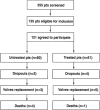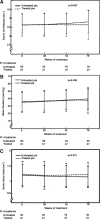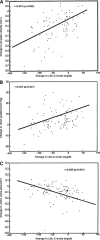Rosuvastatin affecting aortic valve endothelium to slow the progression of aortic stenosis
- PMID: 17276178
- PMCID: PMC3951859
- DOI: 10.1016/j.jacc.2006.07.072
Rosuvastatin affecting aortic valve endothelium to slow the progression of aortic stenosis
Abstract
Objectives: The objective of this study was to test the effect of a 3-hydroxy-3-methylglutaryl coenzyme A (HMG CoA) reductase inhibitor on the progression of moderate to severe aortic stenosis as measured by echocardiography.
Background: Recent retrospective studies support the hypothesis that statins slow the progression of aortic stenosis.
Methods: We performed an open-label, prospective study evaluating 121 consecutive patients with asymptomatic moderate to severe aortic stenosis (aortic valve area > or = 1.0 cm2; mean age 73.7 +/- 8.9 years; 57 men and 64 women), treated with and without rosuvastatin according to the National Cholesterol Education Program Adult Treatment Panel III guidelines. Echocardiographic, serum lipid, and inflammatory markers were measured at baseline and every 6 months for 18 months.
Results: Sixty-one patients (50.4%) with elevated LDL (159.7 +/- 33.4 mg/dl), aortic valve velocity (3.65 +/- 0.64 m/s), and aortic valve area (1.23 +/- 0.42 cm2) received rosuvastatin (20 mg/day), and 60 (49.6%) with a normal LDL (118.6 +/- 37.4 mg/dl), aortic valve velocity (3.62 +/- 0.61 m/s), and aortic valve area (1.20 +/- 0.35 cm2) received no statin. During a mean follow-up of 73 +/- 24 weeks, the change in aortic valve area in the control group was -0.10 +/- 0.09 cm2/year versus -0.05 +/- 0.12 cm2/year in the rosuvastatin group (p = 0.041). The increase in aortic valve velocity was 0.24 +/- 0.30 m/s/year in the control group and 0.04 +/- 0.38 m/s/year in the rosuvastatin group (p = 0.007). There was significant improvement in serum lipid and echocardiographic measures of aortic stenosis in the statin group.
Conclusions: Prospective treatment of aortic stenosis with rosuvastatin by targeting serum LDL slowed the hemodynamic progression of aortic stenosis. This is the first prospective study that shows a positive effect of statin therapy for this disease process. (Rosuvastatin Affecting Aortic Valve Endothelium; http://www.clinicaltrials.gov/ct/show/NCT00114491?order = 1; NCT0014491).
Figures



Comment in
-
Statins in aortic stenosis: new data from a prospective clinical trial.J Am Coll Cardiol. 2007 Feb 6;49(5):562-4. doi: 10.1016/j.jacc.2006.11.002. Epub 2007 Jan 22. J Am Coll Cardiol. 2007. PMID: 17276179 No abstract available.
-
Statins for aortic stenosis? Still waiting for answers.Nat Clin Pract Cardiovasc Med. 2007 Jul;4(7):358-9. doi: 10.1038/ncpcardio0907. Epub 2007 May 8. Nat Clin Pract Cardiovasc Med. 2007. PMID: 17489085 No abstract available.
-
Statins and aortic stenosis in the context of ratio of low- to high-density lipoprotein cholesterol.J Am Coll Cardiol. 2007 Jul 17;50(3):289-90; author reply 290. doi: 10.1016/j.jacc.2007.02.072. Epub 2007 Jun 29. J Am Coll Cardiol. 2007. PMID: 17631225 No abstract available.
References
-
- Lindroos M, Kupari M, Heikkila J, Tilvis R. Prevalence of aortic valve abnormalities in the elderly: an echocardiographic study of a random population sample. J Am Coll Cardiol. 1993;21:1220–5. - PubMed
-
- Roberts WC, Ko JM. Frequency by decades of unicuspid, bicuspid, and tricuspid aortic valves in adults having isolated aortic valve replacement for aortic stenosis, with or without associated aortic regurgitation. Circulation. 2005;111:920–5. - PubMed
-
- Ross J, Jr, Braunwald E. Aortic stenosis. Circulation. 1968;38(Suppl):61–7. - PubMed
-
- Bonow RO, Carabello B, de Leon AC, Jr, et al. Guidelines for the management of patients with valvular heart disease: executive summary. A report of the American College of Cardiology/American Heart Association Task Force on Practice Guidelines (Committee on Management of Patients with Valvular Heart Disease) Circulation. 1998;98:1949–84. - PubMed
-
- Stewart BF, Siscovick D, Lind BK, et al. Clinical factors associated with calcific aortic valve disease. Cardiovascular Health Study. J Am Coll Cardiol. 1997;29:630–4. - PubMed
Publication types
MeSH terms
Substances
Associated data
Grants and funding
LinkOut - more resources
Full Text Sources
Other Literature Sources
Medical

